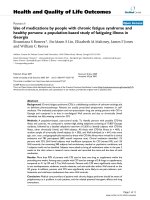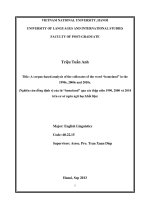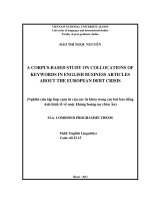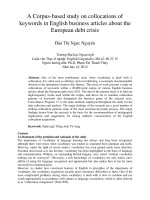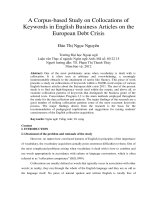A corpus based study of educational discourse the SCORE approach
Bạn đang xem bản rút gọn của tài liệu. Xem và tải ngay bản đầy đủ của tài liệu tại đây (2.59 MB, 266 trang )
A CORPUS-BASED STUDY OF EDUCATIONAL
DISCOURSE – THE SCoRE APPROACH
HONG HUAQING
NATIONAL UNIVERSITY OF SINGAPORE
2009
A CORPUS-BASED STUDY OF EDUCATIONAL DISCOURSE –
THE SCoRE APPROACH
HONG HUAQING
(BA, PGDE, MA)
A THESIS SUBMITTED FOR THE DEGREE OF
DOCTOR OF PHILOSOPHY
DEPARTMENT OF ENGLISH LANGUAGE & LITERATURE
NATIONAL UNIVERSITY OF SINGAPORE
i
ACKNOWLEDGEMENT
Here I’d like to record my sincere gratitude to the following people and
institutions for their support and help for this study.
First of all, I would like to express my heartfelt thankfulness to Dr Vincent
Ooi and Dr Su Jian, for their advice, patience, expertise and encouragement. There
are too many things for which I am indebted to Dr Ooi, who gently and patiently
guided me to apply corpus linguistics into education research, a field I eventually
grew to have a passionate interest in. He is a constant supporter, even during his
sabbatical leave, and he has my profound appreciation for his unfailing guidance
through my professional development. Similarly, none of this work would have been
possible without Dr Su Jian, who is not only my supervisor but also ignited my
interest in natural language processing when I worked with her to build the MEDCo
coreference corpus for information extraction in the Institute for Infocomm Research
(I
2
Secondly, I am also extremely privileged to have Dr Bao Zhiming in the
thesis committee. Dr Bao is in part responsible for my budding enthusiasm for the
pursuit of further study. He has spent countless hours with me as a teacher and
friend. Additionally, he was always interested to hear how I was doing, how I felt
about my work, about any doubts and setbacks I was experiencing, and on every
occasion tried to encourage me by reminding me that writing this up was possible.
R), Agency for Science, Technology and Research (A*STAR), which, together
with the National University of Singapore (NUS), kindly provided me with the
research scholarship for this work.
ii
His unfailing guidance and far-reaching friendship is vital for the development of
this work.
Next, I would also like to thank the group of colleagues who helped this
project in one way or another. During my work on this thesis, I have been a member
of the Center for Research in Pedagogy and Practice (CRPP), National Institute of
Education (NIE), Nanyang Technological University (NTU), and I would like to
thank some members of the center, particularly, Allan Luke, Anneliese Kramer-Dahl
and David Hogan, who supported my research project to build the classroom
discourse corpus, on which this thesis was eventually drawn. As a team, Zheng
Jianzhen, Wu Pengcheng, Niu Guiling, Ao Ran and Hui Chenri have been of
invaluable assistance in processing the data. Paul Doyle, Pauline Appleyard and
Dennis Kwek have given their support and criticism along the way. My thanks also
go to Liu Yongbing, Peter Freebody, Laurence Jun Zhang, Rita Silver and Guo Libo,
for many interesting discussions and comments on corpus-based classroom discourse
analysis.
I have been also indebted to my friends, Gong Wengao, Rinka Watanabi,
Chen Youping, He Jisheng, Zhang Meisuo, Qi Jianping, Zhao Shouhui, and others
who have not been mentioned here but have been by my side all this time.
Finally, my special gratitude also goes to my family for continually
supporting me throughout this extremely stressful stage in my life when I have to
work full time in the day and write this up at night and at the weekend. There is no
way to adequately thank my father, my wife and my daughter for their love,
understanding and tolerance of my 7-11-like work on this project. My daughter, who
iii
grew up with this writing, has assisted the relaxation from my writing by her typical
nagging and reading of fairy tales to me. And she will have more readings from me
now when all this is done.
iv
TABLE OF CONTENTS
ACKNOWLEDGEMENT i
SUMMARY ix
LIST OF TABLES xii
LIST OF FIGURES xiv
LIST OF ABBREVIATIONS xv
CHAPTER 1
INTRODUCTION
1
1.1
Issues and Motivation
1
1.2
The Need for a Corpus-Based Integrated Approach
4
1.3
Rationale and Overall Aim
9
1.4
Methodology and Specific Objectives
12
1.5
Organization of the Thesis
15
1.6
Summary
18
CHAPTER 2
LITERATURE REVIEW
19
2.1
Introduction
19
2.2
Common Approaches to Classroom Discourse
20
2.2.1
Interaction Analysis Approaches
20
2.2.2
Discourse Analysis Approaches
23
2.2.3
Conversation Analysis Approaches
24
2.2.4
Corpus-Based Approaches
28
v
2.3
Some Prior Studies
31
2.3.1
Engagement and Discourse
31
2.3.2
Speech Act in Classrooms
34
2.3.3
Teacher-Student Interaction Patterns
36
2.4
Summary
41
CHAPTER 3
THE SCORE APPROACH: TECHNICAL ISSUES
43
3.1
Introduction
43
3.2
Technical Considerations
43
3.3
Compiling the Corpus Database
45
3.3.1
Recording, Transcribing and Conversion
46
3.3.2
Feature Selection, Annotation Tools and Methods
60
3.3.3
Parts-of-speech (POS) and Semantic Tagging
63
3.3.4
MMAX2 and Multi-layer Standoff Annotation
68
3.3.5
Annotation of IRF Sequences
70
3.4
Database Building and Query
75
3.4.1
Initial Query
76
3.4.2
The Database
77
3.4.3
Web-based Query
79
3.4.4
Advanced Applications
81
3.5
Summary
81
vi
CHAPTER 4
TEACHER TALK AND STUDENT ENGAGEMENT
83
4.1
Introduction
83
4.2
Conversation Text Types in Class
84
4.2.1
Data and Linguistic Features
85
4.2.2
Factor Analysis
88
4.2.3
Cluster Analysis
91
4.2.4
Comparison across School Subjects
95
4.2.5
Comparison between Grade Levels
99
4.3
Teacher Talk and Student Engagement
101
4.3.1
The Engagement Levels
102
4.3.2
Factor Analysis and the Five Dimensions
105
4.3.3
Multidimensional Patterns of Variations
110
4.3.4
Comparing across School Subjects
110
4.3.5
Comparing between Grade Levels
112
4.3.6
Comparing across Stream Types
114
4.3.7
Comparing across Classes of Different Sizes
117
4.3.8
Comparing between Teachers of Different Genders
118
4.3.9
Comparing across Teachers of Different Ages
120
4.3.10
Comparing across Teachers of Different Teaching Experience
122
4.3.11
Comparing across Teachers of Different Qualification
124
4.3.12
Discussion
126
4.4
Summary
128
vii
CHAPTER 5
TEACHER CHOICES OF DIRECTIVES: SPEECH ACT IN
CLASSROOM
129
5.1
Introduction
129
5.2
Regulative Discourse in Class
132
5.3
The Data and Types of Directives in Class
135
5.4
Results
138
5.5
Discussion
147
5.6
Summary
151
CHAPTER 6
IRF AND TEACHER-STUDENT INTERACTION
PATTERNS
153
6.1
Introduction
153
6.2
IRF Sequences in Classroom Teaching
155
6.3
General Distribution Patterns
158
6.3.1
Question Types
161
6.3.2
Pedagogic Purposes
167
6.3.3
Elicitation Strategies
171
6.3.4
Teacher Question and Student Response
176
6.3.5
Teacher Question, Student Response and Teacher Feedback
182
6.4
Discussion
187
6.5
Summary
190
CHAPTER 7
CONCLUSION
193
7.1
Introduction
193
viii
7.2
The Corpus-based Integrated Approach
193
7.3
Technical Perspectives of the Approach
195
7.4
Integration in Linguistic and Pedagogical Studies
197
7.5
Significance and Implications
199
7.6
Limitations and Recommendations
201
BIBLIOGRAPHY
204
APPENDICES
231
Appendix 1
A Simple Flowchart Overview of Singapore's Education
System
231
Appendix 2
A Simple Flowchart Comparison of Singapore's and
American Education Systems
232
Appendix 3
The Singapore Education Landscape
233
Appendix 4
The Streaming in Singapore Schools
234
Appendix 5
A Sample Classroom Observation Coding Sheet
235
Appendix 6
UCREL CLAWS7 POS Tagset
238
Appendix 7
UCREL Semantic Tagset
243
ix
SUMMARY
This study draws on three perspectives, specifically, technical
implementation, linguistic studies and pedagogical applications, so as to propose the
SCoRE approach, a corpus-based integrated approach to the study of educational
discourse. It set outs with a review of some popular theoretical and methodological
approaches to classroom discourse, such as interaction analysis approaches,
discourse analysis approaches and conversation analysis approaches, in terms of their
relative merits and shortcomings from their historical and intellectual development in
relation to the other approaches. Notably, while each of these approaches focuses on
a specific aspect or dimension of discourse and provides a useful and credible view,
none of them, on its own, can provide a full view. Besides, these approaches are rich
in theoretical concepts but thin on data. As a rigorous analysis of data requires an
iterative process of data interpretation and theory generation based on large amount
of evidence, this study therefore attempts to consider how these different approaches
can be harnessed with a corpus-based integrated approach in order to have as
comprehensive a view as is possible. And it intends to combine these approaches to
provide a much richer description and understanding of the complexities and
consequences of classroom practices than any separate efforts could provide.
With this theoretical background available, there are some technical issues to
address in implementing the SCoRE approach. One fundamental issue is how to
design and build the corpus infrastructure for the purpose of “integration”. It is
resolved with a list of decisions and processes of data sampling, manipulation, and
query. For instance, XML is adopted for data storage, and relational database is
x
employed for corpus query. Most importantly, for the purpose of integrating multiple
perspectives from different approaches and research traditions, multi-layered and
multi-leveled stand-off method is adapted for corpus annotation and a flexible web-
based query console is built.
Demonstrating the actual applications of the SCoRE approach in Singapore
education settings, one chapter is devoted to how it can be applied to language
studies of classroom discourse, and another two are focused on how it can benefit
research on pedagogical practices. Linguistically, the corpus provides us with rich
data to look into how teachers and students tend to use language to communicate in
class. Linguistically, the relationship between teacher talk and student engagement
levels is investigated with the sophisticated MD/MF analysis. The patterns are
investigated including conversation text types across subjects, gender, age,
qualification, experience and other social variables in class. Pedagogically, the
sample analyses of speech act and IRE/F patterns in classroom communications also
provide us with a better understanding of how such a corpus-based integrated
approach can benefit education researchers in this aspect.
This study is at least of importance in three aspects. First, with the merits and
shortcomings identified in various approaches to classroom discourses, it proposes a
corpus-based integrated approach which, with a sophisticated architecture, can
support and accommodate research with multiple perspectives from different
traditions. Second, the practical applications both in language and pedagogical
studies support the feasibility and significance of the approach to the study of
classroom practice in educational settings in Singapore and beyond. Finally, the
xi
sample analyses here identified some patterns, views and practices that may not be
able to be captured before such a corpus and the corpus-based integrated approach
were available. Undoubtedly, a number of limitations are also found in present study
and thus some recommendations are provided for future work.
xii
LIST OF TABLES
Table 3.1
General statistics of lessons coded and recorded
48
Table 3.2
Number of P5 units coded and recorded
48
Table 3.3
Number of P5 lessons coded and recorded
49
Table 3.4
Number of S3 units coded and recorded
49
Table 3.5
Number of S3 lessons coded and recorded
49
Table 3.6
Event index in the transcripts
58
Table 3.7
List of index of speakers in the transcripts
58
Table 3.8
Breakdown of the lexical corpus of 455 transcripts of classroom
discourse
59
Table 3.9
A list of the selected features and annotation tools
62
Table 3.10
Breakdown of the IRF-annotated sub-corpus
71
Table 4.1
List of grammatical features used in analysis
87
Table 4.2
Results of the factor analysis
90
Table 4.3
Summary of the factorial structure
91
Table 4.4
Value of Pseudo-F statistic according to cluster number
92
Table 4.5
Summary of Cluster Analysis
92
Table 4.6
Table of cluster means
92
Table 4.7
Table of cluster standard deviation
93
Table 4.8
Summary of cluster analysis across School Subjects
96
Table 4.9
Cluster means across School Subjects
97
Table 4.10
Cluster standard deviation across School Subjects
98
Table 4.11
Summary of Cluster Analysis between Grade Levels
99
Table 4.12
Table of cluster means between Grade Levels
100
Table 4.13
Cluster Standard Deviation between Grade Levels
100
Table 4.14
Distribution of high and low engagement lessons by School
Subjects
102
Table 4.15
Distribution of high and low engagement lessons by Grade Levels
103
Table 4.16
Distribution of high and low engagement lessons by Stream Types
103
Table 4.17
Distribution of high and low engagement lessons by Teacher
Gender
103
Table 4.18
Distribution of high and low engagement lessons by Teacher Ages
103
Table 4.19
Distribution of high and low engagement lessons by Teaching
Experience
104
Table 4.20
Distribution of high and low engagement lessons by Teacher
Qualification
104
Table 4.21
Eigen values for the first five factors
106
Table 4.22
Interfactor correlation matrix of the five factors
106
Table 4.23
Rotated factor pattern (Promax rotation) identified
107
Table 4.24
Five factors identified and the linguistic features associated into 5
dimensions
109
Table 5.1
Selected P5 English Language lessons as the sub-corpus for the
136
xiii
analysis
Table 5.2
Forms of directives, strategy realizations and pedagogic purposes
140
Table 5.3
Examples of most commonly occurring strategy realizations of
directives
143
Table 6.1
Distribution of questions, responses and feedbacks in the corpus
159
Table 6.2
Distribution of types of teacher questions in teacher-student
interaction
166
Table 6.3
Pedagogic purposes in teacher questioning
169
Table 6.4
Distribution patterns of elicitation strategies in teacher questioning
175
Table 6.5
Questions with or without responses from students
177
Table 6.6
Distribution of response types from students
179
Table 6.7
Question types with student response and with or without teacher
feedback
183
Table 6.8
Distribution of feedback types in teacher talk
186
xiv
LIST OF FIGURES
Figure 1.1
The linkage between classroom interactions and perceptions of
pedagogy
10
Figure 3.1
Flowchart of the SCoRE corpus architecture
46
Figure 3.2
A snapshot of transcribing work
53
Figure 3.3
An excerpt of a sample transcript output (trs file)
54
Figure 3.4
An excerpt of human-reader-friendly output (txt file)
55
Figure 3.5
An excerpt of machine-readable output (txt file)
55
Figure 3.6
An excerpt of index file (txt file)
56
Figure 3.7
Importance of feature selection in corpus annotation
61
Figure 3.8
An excerpt of the sample output of Wmatrix POS and semantic
tagging
65
Figure 3.9
A snapshot of File Merger-Splitter
67
Figure 3.10
A snapshot of Comparor
67
Figure 3.11
IRF annotation scheme
73
Figure 3.12
A snapshot of IRF annotation
74
Figure 3.13
A snapshot of IRF patterns
75
Figure 3.14
The database query architecture
79
Figure 4.1
Scree plot of the factor analysis
88
Figure 4.2
Plot of clusters along Dimension 3 vs. Dimension 5
93
Figure 4.3
Multidimensional profiles for conversational text types
94
Figure 4.4
Scree Plot of the factor analysis result
105
Figure 4.5
Profiles of high student engagement by School Subjects
111
Figure 4.6
Profiles of high student engagement by Grade Levels
113
Figure 4.7a
Profiles of high student engagement by Streams (P5)
115
Figure 4.7b
Profiles of high student engagement by Streams (S3)
116
Figure 4.8
Profiles of high student engagement by Class Size
118
Figure 4.9
Profiles of high student engagement by Teacher Gender
119
Figure 4.10
Profiles of high student engagement by Teacher Age
121
Figure 4.11
Profiles of high student engagement by Teacher Experience
123
Figure 4.12
Profiles of high student engagement by Teacher Qualification
125
Figure 6.1
A snapshot of IRF annotation with MMAX2 tool
157
xv
LIST OF ABBREVIATIONS
A*STAR
Agency for Science, Technology and Research
BNC
British National Corpus
CGEL
The Cambridge Grammar of the English Language
CPDD
The Curriculum Planning and Development Division
CRPP
Centre for Research in Pedagogy and Practice
EAGLES
Expert Advisory Group on Language Engineering Standards
ESP
English for Specific Purposes
GSSEC
Grammar of Spoken Singapore English Corpus
I
2
Institute for Infocomm Research
R
IAA
Inter-Annotator Agreement
ICE
International Corpus of English
ICE-GB
Great Britain component of International Corpus of English
ICE-SIN
Singapore component of
IRE
International Corpus of English
Initiation, Response, Evaluation
IRF
Initiation, Response, Feedback/Follow-up
LGSPWE
Longman Grammar of Spoken and Written English
LGSWE
Longman Grammar of Spoken and Written English
MF/MD
Multi-Feature/Dimension (approach)
MMAX
Multi-Modal Annotation in XML
MOE
Ministry of Education
NIE
National Institute of Education
NIECSSE
The NIE Corpus of Spoken Singapore English
NTU
Nanyang Technological University
NUS
National University of Singapore
POS
Parts of Speech
PSLE
Primary School Leaving Examination
SCE
Singapore Colloquial English
SCoRE
Singapore Corpus of Research in Education
SFG
Systemic Functional Grammar
xvi
SGEM
The Speak Good English Movement
SPSS
Statistical Product and Service Solutions, also known as Statistical
Package for the Social Sciences
SSE
Singapore Standard English
XML
Extensible Markup Language
1
Chapter 1
Introduction
1.1 Issues and Motivation
Classroom practices are multifaceted and too complex to be described
completely, and thus the study of educational discourse - the primary means of
classroom practices - has been the focus of many research projects for decades.
Classroom discourse, as the form of educational discourse in classroom practices,
refers to all forms of discourse that take place in the classroom, including linguistic
and non-linguistic elements of the discourse. As Tsui (2008) defines them, the
former includes the language used by the teacher and the learners and the
interactions between them. The latter includes paralinguistic gestures, non-verbal
cues, prosody and silence - all of which are integral parts of the discourse. These
linguistic and nonlinguistic elements constitute the observable dimensions of
classroom discourse. The unobservable dimensions of classroom discourse, typically
formed by the sociocultural contexts in which the discourse is generated, include the
physical environment, the socioeconomic and cultural backgrounds of participants,
as well as the psychological dimensions such as their perceptions, emotions, beliefs
and orientations. Research on classroom discourse has explored both observable and
unobservable aspects as they are hardly divisible.
Discourse analysis, the study of the use of language for communication in
context, is a rapidly-expanding field which is characterized by proliferation of
2
analytical methods and continuously reviewed tools. Discourse analysis, though
often seen as located within the discipline of linguistics, is in fact an interdisciplinary
field of inquiry. With a history of about 50 years, it has been defined as the analysis
of linguistic behavior, written and spoken, beyond the limits of individual sentences,
focusing primarily on the meaning constructed and interpreted as language is used in
particular social contexts. It has attracted the attention not only of linguists and
applied linguists, but also socio-political theorists, sociologists, anthropologists,
computer experts, business and legal specialists, communication experts and
organizational theorists. In this context, it is hardly surprising that discourse analysis
has developed into a variety of schools using different approaches, frameworks,
procedures and methodologies and focused on different kinds of semiotic data, with
the aim of deriving insights for a variety of purposes.
The discourse analytical approaches that have grown out of these
interdisciplinary developments are many, including register and genre analyses,
critical discourse analysis, discursive psychology, conversation analysis,
interactional sociolinguistics, the ethnography of communication, stylistics, mediated
discourse analysis, corpus-based analysis, narrative analysis, multimodal discourse
analysis, rhetorical-grammatical analysis, argumentation analysis and many others.
Work on discourse analysis, ethnography of communication, literary analysis,
semantic analysis, sociolinguistics and text analysis, among others, has developed a
rich body of constructs and methods that are relevant to the analysis of the
construction of meaning in classroom settings. Thus, methodological and theoretical
advances have made it possible to contribute to an understanding of the multiple
3
dimensions of classroom practices, and to the overcoming the earlier limitations on
developing explanations of the differences observed from one or two perspectives
alone.
It is necessary to understand in what way and why these approaches diverge
from common intellectual traditions. In doing so, we hope to understand not just
what is unique about each of these approaches, but also where the possibilities for
convergence and interdisciplinarity are opening up. As will become clearer in the
review of related literature in the next chapter, despite a common commitment to the
study of texts and their use in social contexts, these differences can be seen as the
result of the influence of multiple disciplines on the development of discourse
analysis. For instance, sociology and anthropology have encouraged analysts to view
the use of language as a function of the context in which language is used, whereas
linguistics has constrained discourse analysts to focus primarily on text, with context
in the background.
For applied linguists seeking to establish the roles of teachers and students in
a particular classroom context, the independent insights into the same data from
some rival perspectives can be an advantage. For example, leading exponents of both
Conversational Analysis and Structural Discourse Analysis have often been
dismissive of each others’ approaches (cf. Levinson, 1983: 294; Coulthard & Brazil,
1992: 53). Apparently, the application of both approaches to the same data does
more than just provide different angles on that data. It also provides special insights
that neither field could provide independently. In this sense, it is important to avoid
4
imposing a single framework of analysis that prejudges which categories are
important.
What should become clear on why there are a variety of approaches
commonly applied to the study of classroom discourse is that these approaches are
not developing in isolation, but rather in constant dialogue with one another. While
each focused on a specific aspect or dimension of discourse in educational settings,
none captured the “whole”. In other words, although each individual approach
provides a useful and credible view, none of them, on their own, can provide a full
view.
This present study therefore attempts to consider how these different
approaches can be harnessed and integrated in order to have as comprehensive a
view as is possible. And I hope to combine these theoretical and methodological
approaches to provide a much richer description and understanding of the
complexities and consequences of instructional processes than any separate efforts
could provide.
1.2 The Need for a Corpus-Based Integrated Approach
Educational research has increasingly focused on analyses of teacher-student
and student-student interactions in the classroom (Nystrand, 1997; Westgate &
Hughes, 1997; Luke et al, 2004). Although these classroom studies have been
informed by various theoretical traditions, their major assumption is that teacher-
5
student face-to-face interaction is cultural-linguistic pedagogical communication,
where participants use language and discourse to make sense through dialogic
practices, to exchange and construct meanings, and to engage in complex
interactions (Westgate & Hughes, 1997; Cazden, 1988 & 2001; Hall & Walsh, 2002).
Their emphases have been largely placed on different ways teachers or advanced
learners can scaffold the participation of students in classroom dialogic activities, for
example, by questioning, directing attention to key aspects of the curricular task,
simplifying the task, appropriating language or other tools, monitoring ongoing
performance, and providing appropriate feedback depending on the students’ level of
understanding in classroom interaction (e.g., Carlsen, 1991; Christie, 2002; Mercer,
2000; Skidmore, 2000; Wells, 1999). These are very often analyzed in relation to
local classroom contexts and other contextual factors which influence choices of
particular communicative and pedagogical strategies. These taken together, in turn,
have differential effects on learning and cognition, language development and,
generally, educational achievements (for detailed reviews, see Carlsen, 1991; Hall &
Walsh, 2002; Luke et al, 2004).
There are different methodological tools for examining classroom interaction
or discourse. Among them, discourse analysis is one of the most widely used analytic
techniques in studies of classroom talk (e.g., Green & Dixon, 2002; Hall & Walsh,
2002). However, classroom discourse analysis does not refer to a single disciplinary
or methodological tradition but it is involved with a broad family of techniques and
theories (Green & Dixon, 2002; Rampton et al, 2002). Its strength is in the provision
of detailed micro-analytic descriptions and analysis of dialogic talks in classrooms.
6
The description and analysis can be linked to normative educational and disciplinary
theories to evaluate classroom interaction and to propose educationally viable
alternatives (for reviews, see Green & Dixon, 2002; Rampton et al, 2002; Luke et al,
2004).
However, classroom discourse analysis has so far been difficult to produce
generalizations as there appear to be two areas that need attention. For one thing,
there has been relatively little in the classroom discourse literature that examines
critically the methodological assumptions made in the analysis of data (Tsui, 2008).
As mentioned in previous section, as the field draws on theoretical concepts and
research methodologies from a variety of disciplines, it becomes all the more
important that the methodologies and approaches to specific dimensions should be
extended or redefined to multiple perspectives. In other words, there is a need for a
harnessed and integrated approach to classroom discourse in order to have a
comprehensive view and warranted claims for generalization.
For the other, quantitative analyses of classroom discourse, corpus-based
studies, in particular, are rare if not nonexistent, since common approaches to
classroom discourse are largely just suitable for a small sample size or a case study
(for notable exceptions, see Nystrand, 1997; Applebee et al, 2003) rather than a large
data set. In his TTA lecture, Hargreaves (1996) made a trenchant criticism of
educational research in the UK by saying that “in education there is simply not
enough evidence on the effects and effectiveness of what teachers do in classrooms
to provide an evidence-based corpus of knowledge.” (p. 4). Similarly, in reviewing
7
the education research in the US, Biber et al (2004) pointed out that “to date there
have been few large-scale empirical investigations of academic registers, and
virtually no such investigations of spoken academic registers.” Given this lack of
large quantity of data as support, it has been impossible to generalize the educational
research results on the basis of traditional pen-and-paper approach or observation-
based approach (cf. Cazden, 1988 & 2001; Markee, 2000; Christie, 2002).
Specifically in the context of classroom research, we have lacked the empirically
defined classroom interaction models drawn on a large sample of data.
Fortunately, recently we have seen the progress in this respect.
Methodologically, in the last decade, research on classroom discourse has advanced
the field in several aspects. Firstly, instead of focusing on specific aspects of
classroom interaction, there is emergent research which takes a more holistic view of
classroom interaction, integrates micro- and macro-analyses, and attends to the
multiple dimensions of context and the multiple levels of discourse in the classroom.
Secondly, the theoretical frameworks, which draw on neighboring disciplines to
illuminate the complexity of classroom data, continue to widen. For example, studies
of Lantolf (2000), Van Lier (2000) and Kramsch (2002) have advocated a pluralistic
approach to classroom interaction as a powerful way of capturing the symbiotic
relationship between the language user and the context. This approach offers a new
way of bringing together theoretical frames from other disciplines to enhance our
understanding of the complexities of classroom discourse. Finally, there are an
increasing number of studies which have adopted an eclectic approach to research
methodologies in which qualitative and quantitative data are collected from a variety

